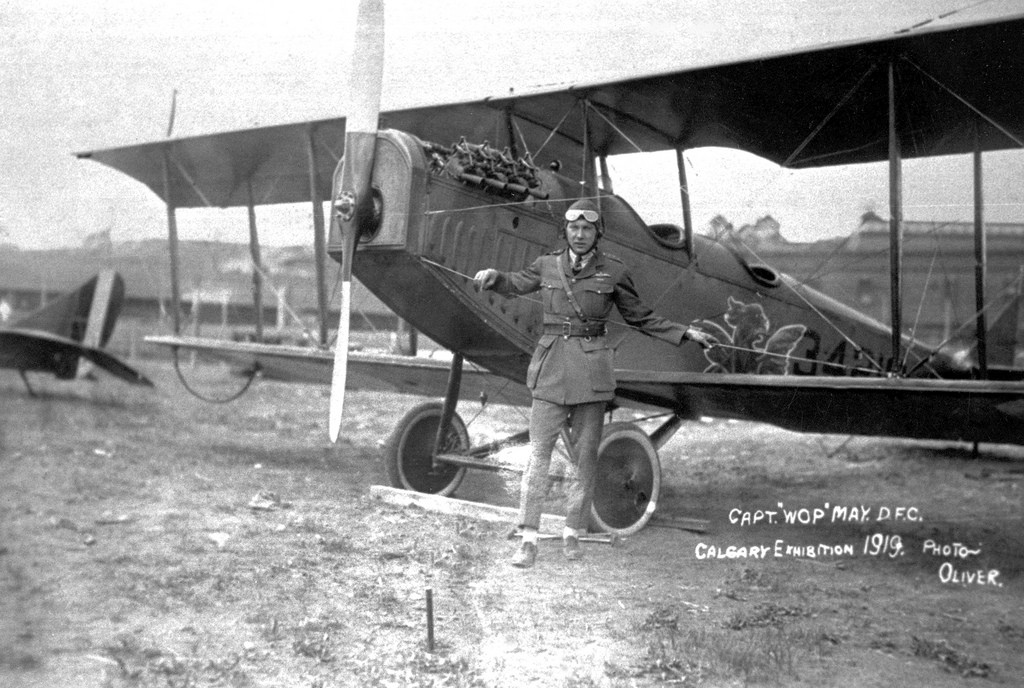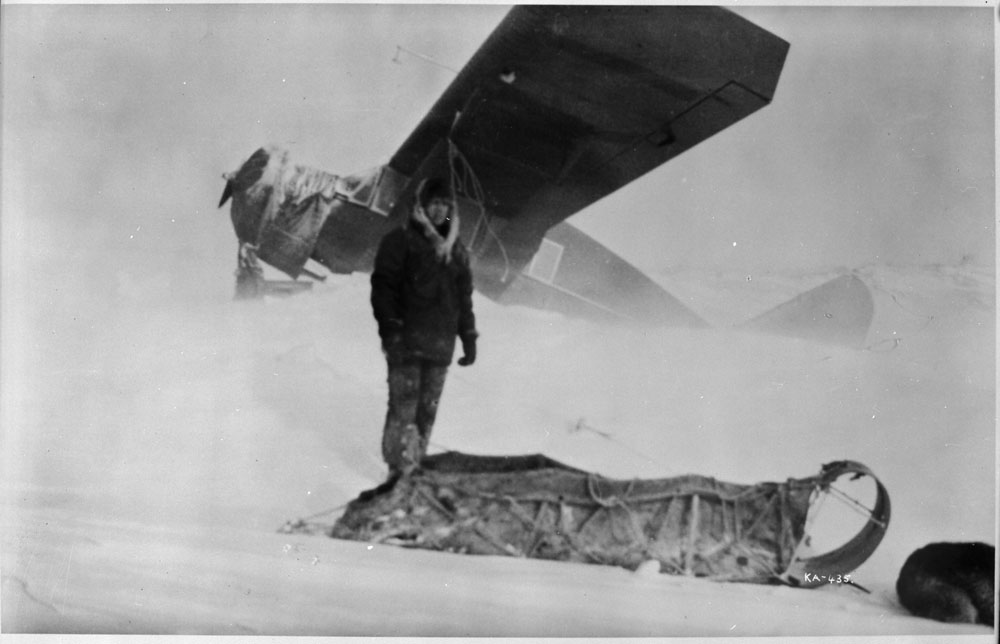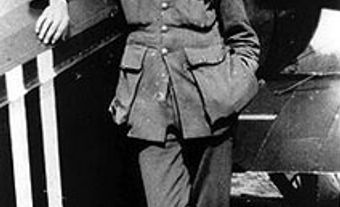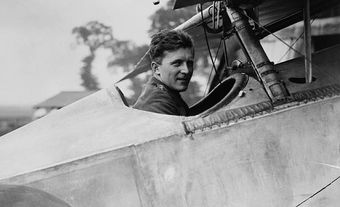Wilfrid Reid (Wop) May, OBE, DFC, aviator, First World War flying ace (born 20 March 1896, in Carberry, Manitoba; died 21 June 1952 near Provo, UT). Wop May was an aviator who served as a fighter pilot in the First World War. May finished the war as a flying ace, credited with 13 victories, and was part of the dogfight in which the infamous Red Baron was gunned down. After the war, May became a renowned barnstormer (or stunt pilot) and bush pilot, flying small aircraft into remote areas in Northern Canada, often on daring missions. May flew in several historic flights, carrying medicine and aide to northern locations and assisting law enforcement in manhunts, including the hunt for Albert Johnson, the “Mad Trapper of Rat River” in 1932.

Early Life
Wilfrid May was the youngest son of Alexander May, a carriage and implements merchant, and his wife Elizabeth. In 1903, the family moved to Edmonton, where May grew up. He acquired his life-long nickname “Wop” when a small cousin mispronounced his first name. One of May’s schoolmates at Edmonton’s High School (now the Victoria School of the Arts) was future flying ace Arthur “Roy” Brown.
First World War and the Red Baron
On 8 February 1916, Wop May joined the 202nd Edmonton Sportsmen’s Battalion of the Canadian Expeditionary Force. He became a machine gun instructor and held the rank of sergeant by the time the battalion was shipped overseas in November 1916 (see First World War). After arriving, May applied to be a pilot, and he transferred to the Royal Flying Corps (soon to be re-named the Royal Air Force) in October 1917. He graduated from training on 28 February 1918, with the rank of Lieutenant. On 9 April, May was assigned to Royal Air Force 209 Squadron. His flight commander was Captain Roy Brown.
May first experienced aerial combat on 21 April over the Somme Canal, flying a Sopwith Camel. His squadron encountered Manfred von Richthofen’s “Flying Circus” and May came under attack by the legendary Red Baron. His guns jammed and he tried to escape the dogfight. Captain Brown saw May in danger and fired a machine gun burst at Richthofen. The German plane crashed seconds later. Brown was credited with shooting down the Red Baron. However, there is still controversy over whether Richthofen was killed by Brown’s fire or Allied ground fire. Still, there is little doubt that Brown’s intercession saved May’s life.
By the war’s end, May had been promoted to captain and was credited with 13 air victories, giving him “ace” status. For courage in action during the Battle of Amiens in August 1918, in which he was wounded, May was awarded the Distinguished Flying Cross. The London Gazette of 3 December 1918, stated, “This officer has carried out numerous offensive and low-bombing patrols, proving himself on all occasions a bold and daring Pilot… His keenness and disregard of personal danger is worthy of the highest praise.”
(See also The Great War in the Air.)
Barnstormer
Wop May returned to Canada after the war. He was issued a civilian pilot’s licence on 7 July 1919. That year, he and his brother Elgin “Court” May formed Canada’s first registered aircraft company: May Airplanes Limited, based in Edmonton. Flying a Curtiss JN-4 “Jenny,” they toured the prairie provinces as barnstormers, performing aerial feats for crowds at exhibitions and rodeos. The company became May-Gorman Aeroplanes Ltd. when George Gorman joined the partnership. Wop May had his name written on the top wing of his biplane so crowds would know who the pilot was when he flew it upside-down.

First Police Manhunt
In September 1919, Wop May participated in the first police manhunt in Canada to use aircraft. John Larson, a recently paroled convict, was the principal suspect in the murder of Edmonton Police Constable William Nixon. Edmonton Police Chief George Hill recruited May to fly Detective James Campbell to Edson, Alberta, where Larson was thought to be heading. With no suitable fields in the vicinity, May landed his biplane on a street in the town. Soon after, Campbell and another police officer apprehended Larson and he was taken back to Edmonton by train. May’s pioneering police-work flight was re-enacted in 2009, and his restored Curtiss biplane is on exhibit in Edmonton’s Royal Alberta Museum.
Bush Pilot

On 7 May 1920, Wop May was issued Commercial Air Pilot Certificate #7, and the May brothers soon established May Field, the first “Air Harbour” in Canada, on a farm near Edmonton. Court’s untimely death in 1922 deeply affected May. However, he continued barnstorming until his marriage in 1924 to Violet “Vi” Bode. May went to work for the National Cash Register Company in Dayton, Ohio, where a training accident left him partly blinded in one eye.
In 1927, May became a founder and the first president and chief flying instructor of Canada’s first licenced flying club, the Edmonton and Northern Alberta Aero Club. It operated from Blatchford Field, a location that is now part of a downtown Edmonton redevelopment. From that field, May and his co-pilot, Vic Horner, embarked on a flight that would make international headlines.
Extreme cold in Canada’s subarctic regions made flying especially hazardous. Pioneering aviators such as May and Gorman who flew into remote northern territories were called “bush pilots” (see Bush Flying). On New Year’s Day, 1929, news reached Edmonton, by telegraph from Peace River, of a diphtheria outbreak in the remote settlement of Little Red River. It could take as long as two months to transport serum to the afflicted community overland by dogsled, and time was of the essence in preventing an epidemic.
At the request of Dr. Malcolm Bow, the Deputy Minister of Health, May and Horner volunteered to fly the medicine to Fort Vermilion, a distance of about 965 km, over unfamiliar terrain. They took off on the morning of 2 January in an open-cockpit Avro “Avian” biplane. The cargo of medicine was wrapped in woolen blankets and stowed in the freight compartment with a charcoal heater to keep it from freezing.

May and Horner flew through snow squalls in subarctic winter darkness and numbing cold. The charcoal heater caught fire, and they had to land, discard it, and pack the serum under their clothing to keep it warm. By the time they landed at Fort Vermilion on the afternoon of 3 January, they were suffering from frostbite (see Cold-Weather Injuries). A fast dogsled transported the medicine the remaining 80 km to Little Red River. May and Horner’s heroic “race against death” drew international attention to the vital work of Canadian bush pilots. In the early 1930s, May carried out many more mercy flights under adverse conditions.
In February 1929, May and Horner started Commercial Airways. Among other services, they inaugurated the first airmail delivery in the Arctic. May was awarded the 1929 Trans-Canada Trophy, and in 1931 Canadian Airways absorbed Commercial Airways.

Hunt for the Mad Trapper
In February 1932, the RCMP requested May’s assistance in their pursuit of a man known as Albert Johnson, dubbed “The Mad Trapper of Rat River” by the press. Johnson had shot two police officers, one of them fatally. For weeks, Johnson, a resourceful woodsman, had evaded capture by using such tactics and backtracking and hiding his tracks in caribou trails. May’s participation marked the RCMP’s first use of aircraft in a manhunt.
Flying a Bellanca monoplane, May ferried men and supplies to strategic locations. He patrolled the country along the Yukon-Northwest Territories border, searching for Johnson’s trail, and reported his findings to the police on the ground. May’s information helped the police close in on the elusive fugitive.
On 17 February, May witnessed the gunfight on the frozen Eagle River in which the police killed Johnson. Speaking of the event in 1952, May recalled, “I was up overhead when [RCMP Inspector] Alex Eames was coming round the bend of the river … He [Johnson] tried to run up the bank to get out of his way. He didn’t have his snowshoes on, and he couldn’t make it so he came back into the centre of the river, dug himself into the snow and the fight started. We [May and flight mechanic Jack Bowen] were up on top and circling, watching the fight and taking pictures of it.”
Later, May flew a wounded officer to Aklavik and then returned to retrieve Johnson’s body.
Later Career and Death
In 1935, May was made an Officer of the Order of the British Empire (OBE). During the Second World War, he volunteered for the British Commonwealth Air Training Plan (BCATP), and he served as general manager of No. 2 Air Observer School (AOS) in Edmonton. As well, he was supervisor of all Observer Schools in Western Canada. During this period, many aircraft were being flown up from the US to Alaska and Russia via Edmonton, along the Northwest Staging Route. Downed pilots (mostly American, but also Russians and Canadians) were often stranded in the bush with help sometimes arriving too late. May’s school was often called out on search and rescue missions, while also assisting in the safe passage of US aircraft en route to Alaska.
May soon conceived the idea of training a squad for a parachute-rescue (para rescue) service for airmen lost in bush country. His first rescue crew, formed in 1943, was composed of civilians from Canadian Airways Training Limited. The concept was soon adopted by the RCAF and came into service after the war. For his assistance to the US, in 1947 May was awarded the American Medal of Freedom, with Bronze Palm, for “meritorious services for the United States Army Air Forces from January 1942 to January 1946.”
After the war, May was employed by Canadian Pacific Airlines (CPA) as Director of Northern Development. In 1951, he became manager of CPA’s repair depot in Calgary. The following year, May died of a heart attack while hiking in Utah. He was inducted into Canada’s Aviation Hall of Fame in 1974.

 Share on Facebook
Share on Facebook Share on X
Share on X Share by Email
Share by Email Share on Google Classroom
Share on Google Classroom


